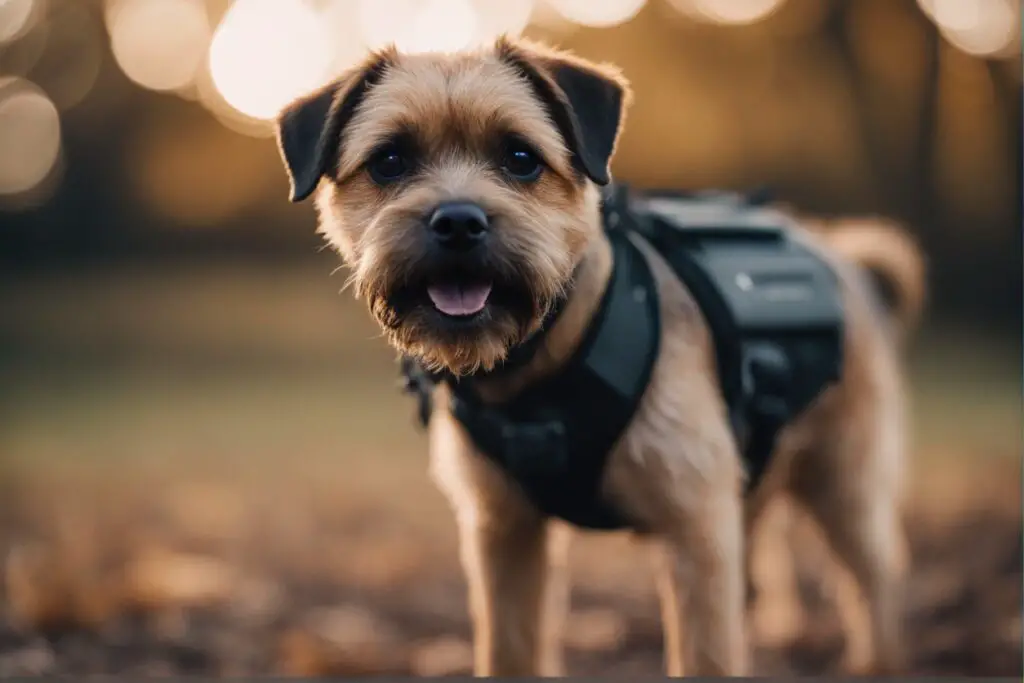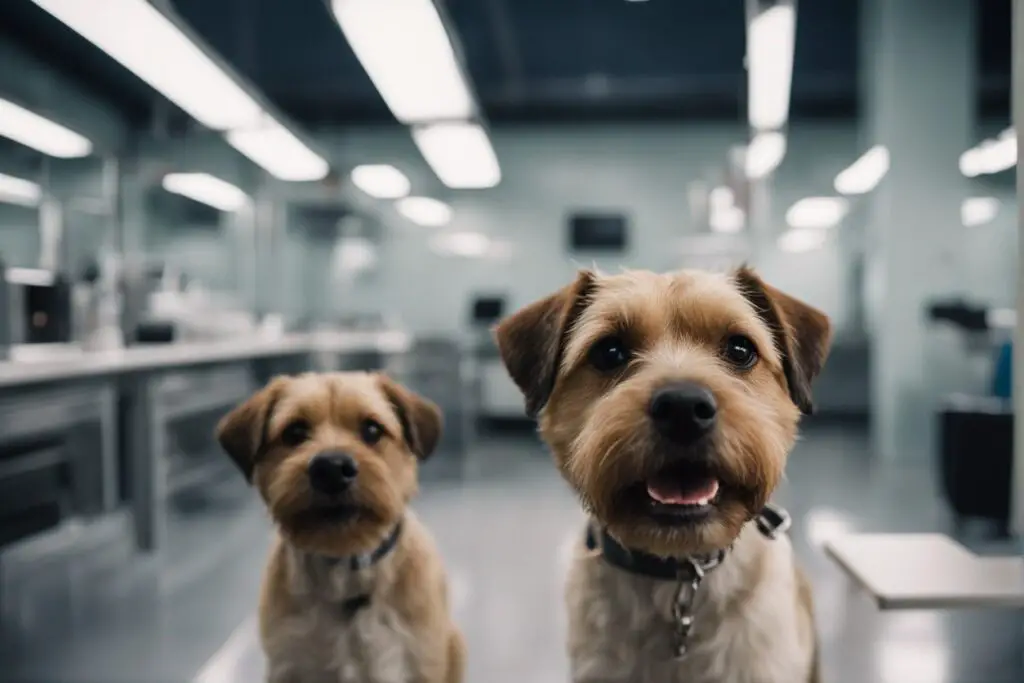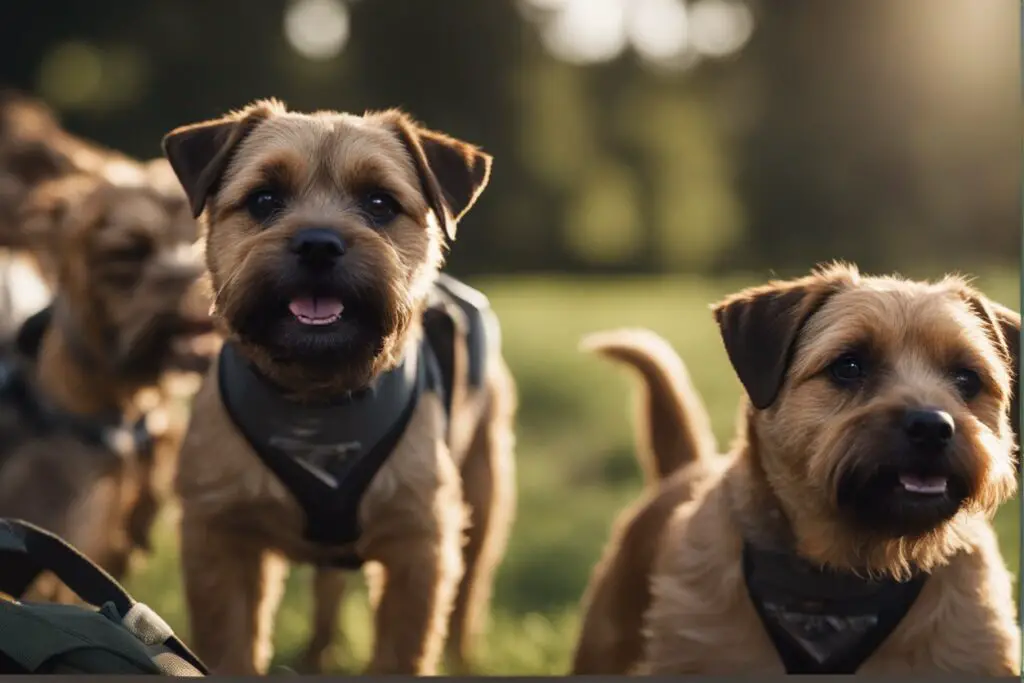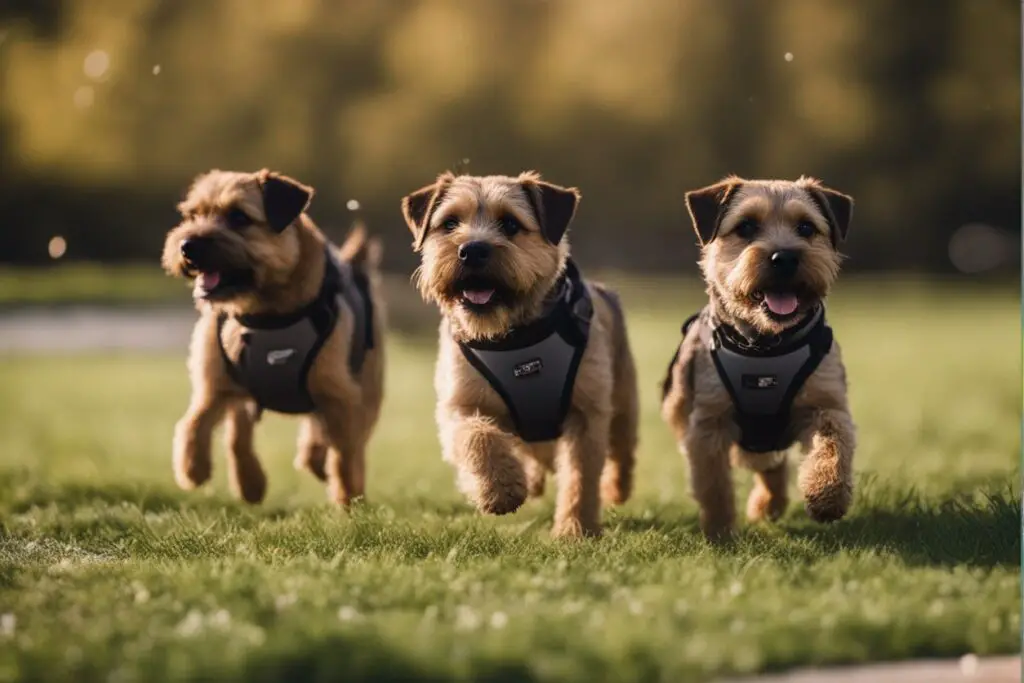Look at those ears- that scruffy beard must be a Border Terrier! Have you crossed paths with these compact dynamos and their signature otter-like heads? Once you spot them, you won’t forget.
These lively pups stand out with their rugged double coats, perfect for bounding through the brush while hunting. But don’t let their rough exteriors fool you – underneath those wiry locks beat affectionate hearts.
With their sharp minds and endless energy, Borders make terrific sporting dogs and devoted companions. Their superb sense of smell ensures no adventure will go unturned. Though small, these mighty pups are passionate about life and learning new tricks.

So, say hello next time you notice those adorable otter heads bopping along! Get to know the loyal, lovable Border Terrier. With their spirited attitudes and zest for fun, they might burrow their way into your heart forever. This unique breed is one unforgettable new best friend waiting to happen.
Table of Contents
- 1 Border Terrier History and Recognition
- 2 Understanding Border Terrier Temperament
- 3 Border Terrier Health and Lifespan
- 4 Training Needs of Border Terriers
- 5 Grooming Essentials for Border Terriers
- 6 Border Terrier Adaptability Factors
- 7 Wrapping Up on Border Terriers
- 7.1 Frequently Asked Questions
- 7.2 How long does a Border Terrier live?
- 7.3 Are Border Terriers easy to train?
- 7.4 What health issues do Border Terriers commonly have?
- 7.5 Do Border Terriers require frequent grooming?
- 7.6 Are Border Terriers good with children and other pets?
- 7.7 Can I keep a border terrier in an apartment?
- 7.8 Is it better to get a male or female border terrier?
- 8 Related posts:
- 9 12 Charming Border Terrier Puppy Behaviour that are the Cutest
- 10 Understanding Border Terrier Shedding: Causes and Solutions
- 11 Do Border Terriers Shed? Unveiling the Truth
- 12 12 Fun Facts About Border Terrier Puppies and Their Quirks
Border Terrier History and Recognition
A Glimpse into the Past
As the name suggests, the border terrier’s origin is deeply rooted in the border region between England and Scotland. This breed was not just a pet or companion for people living in this area; it had a significant role to play. These terriers were initially bred for fox hunting, a popular sport. They were agile, quick, and tenacious – all qualities that made them excellent hunters.
- The border terrier’s history is steeped in tradition.
- They were bred specifically for their hunting prowess.
- They have proved their worth time and again on hunting expeditions.
Picture this – it’s an early morning in the United Kingdom’s border region. The sun is just beginning to peek over the horizon. Men gather around their horses, preparing for another day of fox hunting. Among them are several dogs, but one stands out – it’s a border terrier.

This scrappy little dog has been part of these hunts since its puppy days. From day one, its owner knew this pup had what it took to be a great hunter. With each passing day, love grew between them as they faced countless adventures together.
Recognition Across Borders
Fast forward to 1930, when border terriers gained recognition from none other than the American Kennel Club (AKC). This marked a significant milestone in this breed’s history because AKC recognition opened doors for these little hunters across borders.
- AKC recognized Border Terriers in 1930.
- Part of the prestigious Terrier Group classification.
- It opened up opportunities for international fame and popularity.
So how did these British-born dogs make their way across the Atlantic? Well, word got around about how fantastic these dogs were – not just as hunters but also as family members who brought joy and companionship to their owners’ lives.
And let’s not forget about their inclusion into AKC’s Terrier Group classification! This wasn’t merely an addition to some list but an acknowledgment of their unique traits and capabilities among all other terrier breeds!

Britain’s Oldest Terriers
Border terriers hold another feather in their cap – they’re known as one of Britain’s oldest terriers! It’s like having your piece of history at home with you daily!
- She is known as one of Britain’s oldest terriers.
- Carry centuries-old lineage.
- Living embodiment of British canine history.
Imagine owning a dog whose lineage dates back centuries! Every time you look at your beloved pet, you’re reminded of its individual personality and rich heritage that spans generations!
Understanding Border Terrier Temperament
Good-Natured Pooches
Imagine having a buddy always ready for a good laugh, a companion with an ever-wagging tail. That’s your Border Terrier for you! These dogs are generally good-natured, and their temperament makes them some of the friendliest pets.

- They love to play and have fun.
- They’re always up for a game of fetch or tug-of-war.
- Their cheerful disposition can light up any room.
But don’t let their friendly demeanor fool you into thinking they’re pushovers. These dogs have character!
Independent Streak
Border Terriers are independent creatures with minds of their own. This independence can sometimes translate into stubbornness.
- They might refuse to follow commands that they deem unnecessary.
- Training them could be challenging as they may choose to do things in their way.
- Their stubborn streak can make them quite headstrong at times.
However, this trait also has its positives; it makes them resilient and adaptable to various situations.
Family-Oriented Canines
Being part of a family unit is fundamental for these social creatures. They thrive on companionship and enjoy being included in all family activities.

- Whether going on family trips or simply lounging on the couch watching TV, they want in!
- The bond between Border Terriers and their human families is vital and deep-rooted.
- They see themselves as members of the pack, not just pets.
Their sociability extends beyond human interactions too!
Socializing with Other Dogs
If properly socialized from an early age, Border Terriers tend to get along well with other dogs.
- Puppy classes can be beneficial for teaching them how to interact appropriately with other pups.
- Regular dog park visits can provide opportunities for socialization and playtime with other furry friends.
- Playdates with neighbors’ pets could also help develop their social skills further.
Although friendly by nature, there’s another side to these terriers that shouldn’t be overlooked!
Protective Instincts

While not typically aggressive, Border Terriers aren’t afraid to stand their ground when necessary due to their protective instincts.
- They won’t hesitate to act protectively if they sense danger or perceive a threat to their loved ones.
- Despite their small size, they’re brave little warriors defending what matters most – their family!
- It’s important not to mistake this protective behavior for aggression; it’s simply part of the package that comes with these loyal pooches’ temperament!
Border Terrier Health and Lifespan
The Life of a Border Terrier
Life is a journey. Well, this journey typically lasts 12 to 15 years. That’s quite a bit of time, considering dog years! This breed tends to be robust and hearty, often living entire lives with few health problems.
But what does life look like for these little guys? Well, it’s filled with playtime, walks in the park…and, yes, regular vet visits. Like humans, as do our furry friends, we need check-ups to catch potential issues early on. Regular vet check-ups are essential for detecting health issues that might sneak up on your border terrier early.

Don’t get me wrong; I’m not trying to paint a grim picture or anything. Compared to other breeds, border terriers are generally considered healthy breeds with only a handful of genetic problems. But it doesn’t hurt to stay ahead of the game – you know what they say about an ounce of prevention!
Potential Health Problems
“Every rose has its thorn,” as the song goes – and even though border terriers are generally healthy dogs, they have their share of potential health problems too. For instance, they can be prone to hip dysplasia and heart defects.
Hip dysplasia is when the hip joint doesn’t fit together correctly – like trying to put a square peg in a round hole – it just doesn’t work out too well! This can lead to pain and difficulty moving around.
Heart defects are another issue that may affect your border terrier’s quality of life. These defects range from minor ones that don’t cause noticeable symptoms to severe conditions requiring medical intervention.

Again though – let me stress this: these issues aren’t guaranteed! They’re just potential problems that might crop up due to genetics or environmental factors.
Skin Conditions and Allergies
Do you know how annoying allergies can be? Imagine dealing with them when you’re covered in fur! Some border terriers may suffer from allergies or skin conditions, making them uncomfortable or even downright miserable.
These conditions could manifest as dry skin (dandruff but for dogs), rashes, or hot spots (areas where your dog won’t stop scratching). Allergies could also trigger symptoms such as sneezing (yes, dogs sneeze!), itching, or digestive issues if it’s food-related.
So there you have it, folks – the lowdown on the health and lifespan of our beloved border terriers. Remember: while these potential health problems might seem scary at first glance, most aren’t everyday occurrences, and regular vet check-ups will help keep your pup in tip-top shape throughout its long life.
Training Needs of Border Terriers
Positive Reinforcement Works Best
Like many other breeds, Border terriers respond best to positive reinforcement training methods. This means rewarding good behavior rather than punishing bad behavior. So, if your border terrier does something right, give them a treat or praise them enthusiastically.

These dogs are intelligent and eager to please, so they’ll quickly learn that doing what you want leads to rewards. However, it’s important not to overdo the treats – too many can lead to weight gain and health problems. Instead of always using food as a reward, try using toys or playtime.
Consistency is critical in this type of training. If you reward your dog for sitting on command one day but ignore the same behavior the next day, they’ll get confused about what you want from them. Please ensure everyone in your household knows and sticks to the rules.
Early Socialization is Crucial
Another crucial part of training border terriers is early socialization. These dogs were initially bred for hunting, which means they have a high prey drive and can be aggressive toward other animals if not properly socialized.
The best way to socialize a border terrier is by exposing them to a wide variety of people, animals, and environments from an early age. This could include taking them to dog parks or arranging playdates with friends’ pets.
Rescue groups often provide socialization opportunities through organized events or meetups with other adopters.

Mental Stimulation is Required
Due to their high intelligence levels, border terriers require plenty of mental stimulation and physical exercise. Without enough mental stimulation, these dogs can become bored and destructive.
There are many ways you can provide mental stimulation for your border terrier:
- Puzzle toys that dispense treats when solved
- Teaching new tricks or commands
- Agility courses
- Tracking exercises
Remember that consistency is key here, too – try incorporating mental stimulation into your dog’s daily routine.
Consistent Training Sessions are Key
As mentioned earlier, consistency is vital when training border terriers. This applies to the type of rewards you use and the timing and frequency of your training sessions.
Try setting aside specific times each day for training sessions rather than trying to squeeze them in whenever you have a spare moment. Regularity helps reinforce lessons learned and keeps things fresh in your dog’s mind.

Excel at Various Dog Sports
Finally, due to their natural agility and intelligence, Border Terriers excel at various dog sports like agility trials, obedience competitions, and tracking exercises. Participating in these activities provides both physical exercise and mental stimulation, fulfilling two critical needs at once.
Grooming Essentials for Border Terriers
A Brush with Destiny
You’ve got a Border Terrier, eh? That’s one wiry outer coat to contend with. The double coat of these small dogs is a unique feature and requires regular brushing. It’s not just about making your pup look like the belle of the kennel club ball but keeping them healthy and comfortable too.
- Regular brushing helps keep shedding in check. You might find less hair on your favorite couch or rug.
- It stimulates their skin, promoting better circulation and overall skin health.
- And let’s not forget – it strengthens your bond with your little friend.
So grab that brush, call over your four-legged buddy, and get down to business. But remember, be gentle – you’re dealing with a living being here, not scrubbing a dirty pot.

Professional Touch
While you’ll be doing most of the grooming at home, calling in the pros twice a year can make a difference. They know their stuff and can handle tasks like stripping (removing dead hair from the coat by hand) without causing discomfort or harm to your small dog.
- Look for groomers who are experienced with Border Terriers.
- Schedule appointments well in advance – good groomers are often booked solid.
- Discuss any specific concerns about your pet’s coat or overall grooming needs.
Remember, this isn’t just about aesthetics; professional grooming contributes significantly to their health and well-being.
Bath Time? Maybe Not…
Contrary to what those doggie shampoo commercials might have you believe, frequent baths aren’t always best for our canine pals – especially for breeds like Border Terriers that have natural oils in their coats that protect their skin.
Overbathing can strip these oils away, leaving their skin dry and irritated, which is no fun! So save bath time for when they need it – maybe after an adventurous romp through muddy fields or an unplanned encounter with some small animals (you know how curious they can get).

Nails & Teeth: Not Just Human Concerns
Don’t overlook those nails and teeth, either! Regular nail trimming prevents problems like overgrown nails, which can cause discomfort while walking or running on a leash. And dental hygiene? Just as important as it is for us humans!
- Regular brushing helps prevent gum diseases.
- Dental chews can supplement brushing.
- Annual dental check-ups are also recommended.
So there you go! Grooming essentials for border terrier puppies (and adults) might seem daunting initially, but it becomes second nature once you get into the swing of things. Always remember: proper grooming = a happy dog!
Border Terrier Adaptability Factors
Apartment Living
Who says size matters? The border terrier’s modest weight and compact form prove that good things come in small packages. These dogs can adapt well to apartment living, given the right conditions. They don’t need a massive area like larger canine cousins to roam around. But don’t be fooled by their size. They pack quite an energy level into that tiny frame.
You see, these furry friends are high on activity levels. So, while they might not need much space, they require ample exercise time. Whether it’s a long walk in the park or a game of fetch in your living room – keeping them active is vital to avoid potential problems like destructive behavior or excessive barking.

Speaking of barking, let’s chat about that for a sec. Border terriers have a moderate tendency to bark, which could potentially ruffle your neighbors’ feathers if you’re living in close quarters. But hey! With sufficient exercise and mental stimulation, this shouldn’t pose too much of an issue.
Climate Tolerance
Another point on our list is climate tolerance. Border terriers aren’t just adaptable.
Have they got hot summers? No problemo! These guys can tolerate heat pretty well if they can access fresh water and shade during peak sun hours.
Live somewhere where winter means snow? That’s cool (pun intended)! Their dense double coat provides insulation against cold temperatures.
But remember, folks: extreme weather conditions can pose health risks for any pet, so constantly monitor them closely during periods of intense heat or cold!
Trainability
Hey, first-time dog owners! Are you looking for an easy-to-train breed? Well then, meet the border terrier – your new best friend! Known for their intelligence and eagerness to please, these dogs are relatively straightforward to train, even if you’re new at this whole ‘dog owner’ thing.

Their high energy levels mean they’re always up for learning new tricks or commands, making training sessions fun rather than frustrating.
But here’s the kicker: while border terriers are generally easy-going and obedient, they have a stubborn streak (don’t we all?). It’s important not to mistake their small size and pleasant nature for passivity – these dogs have their minds!
Family Compatibility
They are wondering if border terriers are good with kids. Absolutely! Their friendly disposition makes them excellent family pets. Plus, their energy level perfectly matches active children who love playing outdoors!
However, remember that every dog has limits – teaching children how others should adequately interact with pets is crucial from the get-go.
So there you have it, folks! A comprehensive guide on why border terriers make excellent pets, especially if you’re looking at adaptability factors such as apartment suitability, climate tolerance, trainability, and family compatibility. Remember though: every dog deserves love and care, so ensure you’re ready before welcoming one into your home!

Wrapping Up on Border Terriers
So, there you have it! Everything you need to know about the lovable Border Terrier. These little guys are full of life and character, perfect for those looking for a loyal companion. They might be small, but they’re tough cookies with a lifespan that can surprise you. Remember, training and grooming are vital to keeping them happy and healthy.
Ready to welcome a Border Terrier into your family? Take the plunge! You won’t regret adding this bundle of joy to your life. Remember, every dog deserves a loving home where they can thrive. So go ahead – make your home that place for a Border Terrier!
Frequently Asked Questions
How long does a Border Terrier live?
A healthy Border Terrier can live between 12-15 years on average.
Are Border Terriers easy to train?
Yes, they are known for their intelligence and eagerness to please, making training more accessible than other breeds.
What health issues do Border Terriers commonly have?
Yes, they are known for their intelligence and eagerness to please, making training more accessible than other breeds.
Do Border Terriers require frequent grooming?
Their wiry coat requires minimal grooming – just regular brushing and occasional hand-stripping.
Are Border Terriers good with children and other pets?
Absolutely! They are known for their friendly nature towards both kids and other animals.
Can I keep a border terrier in an apartment?
Sure thing! As long as they get enough exercise daily, these adaptable pups can live happily in apartments too.
Is it better to get a male or female border terrier?
Both sexes make excellent pets; it mostly comes down to personal preference!